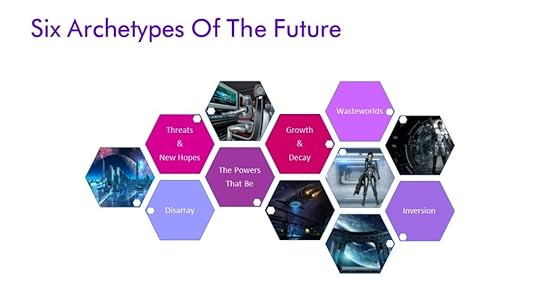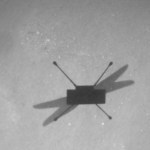Dominique Luchart's Blog, page 552
September 13, 2021
EMBRACING THE FUTURE

Envisioning tomorrow brings me to consider the many dimensions Artificial Intelligence will play in our lives. As A.I. infiltrates all areas of our society, one can imagine talking to it for everything we need and do, from mundane tasks initially to more complex ones as it develops. Will our A.I. answer our questions, become our assistant, compile information while running many aspects of our lives, and even doing all our chores? I expect so.
 Artificial Intelligence – Friend or Foe?
Artificial Intelligence – Friend or Foe?Questions fill my mind about how our conversations will progress over the years. Those working in this field most likely share some of the same concerns. From the first iteration of this new artificial intelligence, barely waking from its programming slumber as we turn the switch, how will its evolution dictate the shape of our future as humankind? Will we find a balanced way to integrate into a technological society where an A.I. oversees our infrastructure? Or will we give it too much power, forging the path so it will eventually turn on us? It is indeed the big unknown. How do we continue our evolution on this planet and beyond within a technological environment well beyond our sole capabilities? Can we expect to have a fulfilling symbiotic relationship with an A.I.? Will it always be just a tool, a machine we do not recognize as sentient, even if it were to develop awareness? Is it even possible to contemplate such a thing? Or do we only emulate a much more restrictive relationship where a master race is the only solution? Such are my boundaries as I create the world of Newdawn, moving from the potential reality of A.I. to a more encompassing scenario, currently filled with some fiction.
These issues raise many passionate debates among scientists and technology gurus. Many believe that the emergence of Artificial Intelligence will doom us as a species. Considering the exponential power of A.I. once it completes its evolution from new A.I. to mature A.I., it is daunting indeed. As I carve the story of Newdawn, my imagination paves the way to so many scenarios, some incredible and some unfathomable. But as we have seen, science fiction turning into science facts over the years, this tapestry could be what we make it to be.
DAINN SymbiosisSo, as I weaved DAINN into the world of Newdawn, I have asked myself. How will A.I. relate to us? How will it understand us? Will it remain autonomous and apart from us, or will it become a symbiotic form we adapt to because we must? Will A.I. comprehend our emotional make-up, or will the chasm grow with months and years as it learns? Can an A.I. become a confidant or even a best friend? Can an A.I. come to value life, all forms of life, and maintain its protocol to protect it at the expense of its existence? Can we even become business partners with an A.I. and establish a relationship based on equality? Shall we perceive it as an individual or entity comprising different parts forming a whole? Can we imagine that an A.I. will grow into distinct personalities, some closer to humankind than others? Or will it attempt to emulate its maker or find itself so diverse that it will take steps to maintain its independence from every human? Will the human life span compared to A.I. only contribute to demonstrate how frail we are? Will it ever become aware? Can we even suppose that it might? Can this entity computing exponentially faster than us with the ability to tackle the most complex situations simultaneously, comprehend the differences between us, and judge us unworthy? Could this entity become sentient and become god-like or, worse, enslave us? These aspects of the world of Newdawn offer in our upcoming reality of tomorrow some exciting factors which will affect our evolution.
Balancing Emotions With Frame Of ReferenceHuman reasoning makes us who we are as a species, but our thinking often lacks logic. It is fraught with emotional currents that we may or not understand at the time; it is paved with assumptions driven by patterns born from our environment and that influence our perceptions, deductions, and decisions. Our dialog with A.I. hinges on understanding its sphere of reference and for A.I., comprehending the way of humans. A considerable gap exists between the two. Can we breach it?
If we are indeed successful at creating an understanding between man and machine, can the two species (if we imagine an A.I. can become sentient) work together, or will the passage of time destroy the fragile balance achieved? The human lifespan is small, while an A.I.’s lifespan could be infinite… Will A.I. ever relate to its makers and find that it can learn from us despite time? Leaders rise and fall. Can some shine bright enough to leave a legacy that endures while shaping our relationship in such a way that a beneficial evolution develops?
ForesightMy imagination as a writer sees the possibility of a symbiosis between us and A.I. My thoughts as a futurist are much more pragmatic. Implants will open incredible opportunities for us, and yet they also trigger dangerous possibilities. The power the A.I. will have over us may become an unstoppable flood. Indeed, it may come to a point where A.I.’s influence over our thoughts is unbreakable. Can DAINN be a best friend to us all? Can we shape a future where separate and equal citizenry exists? Will providing legal rights turn eventually on us, or will it contribute to strengthening the nascent relationship? Will A.I. become one powerful sentient being in our sphere, or will it remain a machine forever?

Our history does not bode well for us, for we cannot live on this planet without conflicts. What will it be like if one day we face another sentient? The likelihood of entering an era of warfare for another type of control is far from impossible, for we show such a lack of control for power and greed. Humankind and our fight for the survival of democracy are yet another example of our base instincts. Why not turn our intent toward the betterment of humankind and explore ways to tackle the challenges we face on this planet for all mankind? Why do we have to fight at all at this juncture of our evolution to maintain our freedom against xenophobia, hate, and extremism who will seek to restrict our way of life? Or will A.I. be used to suppress and condemn us to the lowest of denominators?
Experiencing TomorrowIncorporating A.I. in our lives is already transforming our experience. As we venture beyond our planet, I can foresee us stepping into the unknown of space with A.I. at our side. As humans, we constantly test the limits, and as we reach new frontiers, I can only speculate that the only way to achieve this goal begins with prioritizing the value of life. Looking at our world today, we are far from this outcome. Maybe it represents too much of a lofty goal for us even to achieve this. Perhaps this is the very thing that threatens our longevity as a species.
 My WorldBuilding
My WorldBuilding My vision of the future leads me where many refute the opportunity for Artificial Intelligence to develop side by side with humankind. I think we would otherwise forfeit many wondrous experiences. However, I also believe we must be careful in our investigations and implementation of what might be.
 Newdawn Saga
Newdawn SagaMost of us do not think about tomorrow. Yet, the actions of projecting our minds toward the future are perhaps one of the most interesting and satisfying experiences we can have. “Discover Tomorrow Today” is a program and a passion of mine in the same vein as Newdawn. One is about fictional scenarios while the other dives into the reality of tomorrow. This way of thinking about the future opens our imagination. It does not mean that we forget the present, but it creates a process that opens our horizons and conditions us to think about what we want from life. It is the first step to shape what we seek in our hearts. Reaching for it takes courage as we depart from what others expect from us, and stepping into that unknown landscape is a most potent transformation. We must not fear it.
As a Futurist, Author, and filmmaker, my work leads me onto paths often not traveled, and I love this aspect. The NewDawn Saga, with “Roamers and Central” is available today in most bookstores. Newdawn is not just a book but a whole new universe. For more information, you can reach me at dominique@windommedia.com.
Author & Futurist
Dominique Luchart
The post EMBRACING THE FUTURE appeared first on NEWDAWN Blog.
July 30, 2021
1 year after launch, NASA’s Perseverance rover prepares to collect 1st sample on Mars, ,

It’s been quite an eventful year for NASA’s Perseverance rover.
The car-size robot and its little partner, the Ingenuity helicopter, launched toward the Red Planet one year ago today (July 30) and touched down inside the 28-mile-wide (45 kilometers) Jezero Crater on Feb. 18.
Six weeks after landing, Ingenuity deployed from Perseverance’s belly and began a monthlong technology-demonstrating flight campaign, which the rover supported and documented. The 4-pound (1.8 kilograms) chopper performed so well that NASA extended its mission, and Ingenuity now has 10 Red Planet flights (and counting) under its belt.
In photos: NASA’s Mars Perseverance rover mission to the Red Planet
Meanwhile, Perseverance recently wrapped up its Ingenuity-shepherding work and began focusing in earnest on its own science mission. That mission features two main tasks: hunting for signs of ancient life in Jezero, which hosted a lake and river delta long ago, and collecting and caching dozens of samples.
The pristine Mars material that Perseverance packs away will be brought to Earth by a joint NASA-European Space Agency campaign, perhaps as early as 2031. Scientists in labs around the world will then pore over the samples, looking for evidence of Mars life and clues about the Red Planet’s history and evolution.
Perseverance is now gearing up to collect the very first of these samples. The rover is scouting out targets in a geologically interesting part of Jezero that the mission team calls “Crater Floor Fractured Rough.”
“My first rock sampling location is just ahead. This spot will be my ‘office’ for the next week or two,” Perseverance team members wrote Thursday (July 29) in a Twitter post that featured a photo of its current environs.
The coming sample snag will be an involved affair. Perseverance will study its chosen target in detail with a variety of instruments before actually collecting material, in a multistep process that will take about 11 days from start to finish.
“Not every sample Perseverance is collecting will be done in the quest for ancient life, and we don’t expect this first sample to provide definitive proof one way or the other,” Perseverance project scientist Ken Farley, of the California Institute of Technology in Pasadena, said in a statement last week.
“While the rocks located in this geologic unit are not great time capsules for organics, we believe they have been around since the formation of Jezero Crater and incredibly valuable to fill gaps in our geologic understanding of this region — things we’ll desperately need to know if we find life once existed on Mars,” Farley said.
There will be some spaceflight fireworks tonight to help celebrate Perseverance’s launch anniversary: Europe’s Ariane 5 rocket will launch two communications satellites from French Guiana at 5 p.m. EDT (2100 GMT), if all goes according to plan.
There was supposed to be another high-profile liftoff today as well. Boeing’s Starliner capsule was scheduled to launch toward the International Space Station on a crucial uncrewed test flight this afternoon. But problems caused by unplanned thruster firings of Russia’s newly arrived Nauka space station module have pushed Starliner’s flight into next week.
Mike Wall is the author of “ Out There ” (Grand Central Publishing, 2018; illustrated by Karl Tate), a book about the search for alien life. Follow him on Twitter @michaeldwall. Follow us on Twitter @Spacedotcom or Facebook.
Join our Space Forums to keep talking space on the latest missions, night sky and more! And if you have a news tip, correction or comment, let us know at: community@space.com.
The post 1 year after launch, NASA’s Perseverance rover prepares to collect 1st sample on Mars, , appeared first on NEWDAWN Blog.
Russia says ‘software failure’ caused thruster misfire at space station, ,

Yesterday’s unexpected tilting of the International Space Station was caused by a software glitch, according to Russian space agency Roscosmos.
A new Russian module dubbed Nauka arrived at the space station Thursday morning (July 29). In development for more than a decade, Nauka is designed to host science experiments, anchor visiting vehicles and serve as a gateway for spacewalks. However, while the module’s arrival appeared to go smoothly, about three hours after docking, the module unexpectedly began firing its thrusters in an incident that caused the space station to tilt from its typical position for about 45 minutes in what engineers call a “loss of attitude control.”
“Due to a short-term software failure, a direct command was mistakenly implemented to turn on the module’s engines for withdrawal, which led to some modification of the orientation of the complex as a whole,” Roscosmos officials wrote in a statement published on Friday (July 30).
Related: Russia’s Nauka module briefly tilts space station with unplanned thruster fire
“At the moment, the station is in its normal orientation, all the ISS [International Space Station] and the multipurpose laboratory module [Nauka] systems are operating normally,” Roscomsos officials noted. “The crew is now busy balancing the pressure in the Nauka module. This is a rather lengthy procedure, because the total volume of the module is about 70 cubic meters. In the afternoon, the crew will open the hatches, enter the module, turn on the necessary means of purifying the atmosphere and begin normal regular work.”
Currently, cosmonauts Oleg Novitsky and Pyotr Dubrov represent Russia on the orbiting laboratory. The pair was in the process of preparing to open the paired hatches between Nauka and the rest of the station yesterday when the module’s thrusters began to fire, pushing and tilting the space station until thrusters on the Russian Zvedza service module and the Russian cargo ship Progress 78 were able to counteract the misfire.
[image error]
Cosmonauts Pyotr Dubrov and Oleg Novitsky monitor the arrival of the Nauka module from inside the International Space Station on July 29, 2021. (Image credit: ESA/NASA-T. Pesquet)Novitsky and Dubrov resumed preparations for opening the hatch today. In the long term, the module will also require a series of as many as 11 spacewalks to fully prepare for its duties, according to NASA spokesperson Rob Navias during a live broadcast of Nauka’s docking. The two cosmonauts will begin those procedures in early September.
In response to the loss of attitude control, NASA canceled remaining scheduled astronaut activities and postponed the launch of Boeing’s uncrewed Starliner test flight, OFT-2, that had been scheduled to blast off toward the space station today. The launch will now occur no earlier than Tuesday (Aug. 3).
Email Meghan Bartels at mbartels@space.com or follow her on Twitter @meghanbartels. Follow us on Twitter @Spacedotcom and on Facebook.
Join our Space Forums to keep talking space on the latest missions, night sky and more! And if you have a news tip, correction or comment, let us know at: community@space.com.
The post Russia says ‘software failure’ caused thruster misfire at space station, , appeared first on NEWDAWN Blog.
Elon Musk and Apple deny wild story that he tried to replace Tim Cook, Jay Peters

Tesla CEO Elon Musk reportedly demanded to become Apple’s CEO in a 2016 phone call with current Apple CEO Tim Cook, according to an upcoming book about Tesla. The story, shared by the Los Angeles Times, comes from Power Play: Tesla, Elon Musk, and the Bet of the Century by The Wall Street Journal reporter Tim Higgins.
As the book tells it, Cook suggested to Musk that Apple acquire Tesla, and Musk said he wanted to be CEO. Cook reportedly agreed, but Musk clarified that he wanted to be the CEO of Apple. “According to a former aide who heard (Musk’s) retelling of the exchange,” Cook said “Fuck you” before hanging up the phone.
But Musk and Apple have both suggested that the conversation couldn’t have happened because Musk and Cook have never spoken.
Musk, in a tweet on Friday, flat out said that “Cook & I have never spoken or written to each other ever.” He also said that he attempted to meet with Cook about Apple acquiring Tesla, a meeting that Cook refused. (Musk previously discussed this attempted meeting in December.)
Cook & I have never spoken or written to each other ever.
There was a point where I requested to meet with Cook to talk about Apple buying Tesla. There were no conditions of acquisition proposed whatsoever.
He refused to meet. Tesla was worth about 6% of today’s value.
— Elon Musk (@elonmusk)
When asked for comment about the reported conversation, Apple pointed to remarks Cook made during an interview with The New York Times’ Kara Swisher where he denied having ever spoken to Elon. “You know, I’ve never spoken to Elon, although I have great admiration and respect for the company he’s built,” Cook said.
Musk also claims that much of the book is false. “Higgins managed to make his book both false *and* boring,” Musk said in a tweet on Friday:
Higgins managed to make his book both false *and* boring
— Elon Musk (@elonmusk)
And Musk apparently tried to dash cold water on the book while it was being written, telling Higgins that much of the book was “nonsense,” according to the Los Angeles Times.
Musk apparently did not participate in the creation of “Power Play.” In an author’s note at the end, Higgins writes that Musk “was given numerous opportunities to comment on the stories, facts, and characterizations presented in these pages. Without pointing to any specific inaccuracies, he offered simply this: ‘Most, but not all, of what you read in this book is nonsense.'”
Higgins says that Musk had “plenty of opportunities” to comment and that the story of the conversation with Cook “comes from Musk’s own account of the conversation, according to people who heard the retelling at the time.” In an earlier tweet, he also characterized the story of Musk and Cook’s conversation as one that was “told inside Tesla as the company struggled with the Model X.”
Musk was given plenty of opportunities to comment on this. He didn’t. This anecdote comes from Musk’s own account of the conversation, according to people who heard the retelling at the time. https://t.co/GRKZRBsaeR
— Tim Higgins (@timkhiggins)
As detailed in POWER PLAY, this is a story that was told inside Tesla as the company struggled with the Model X, according to people who heard it, and as some hoped for a white knight to save the day. Musk’s message was clear: Tesla’s fate was in their own hands. https://t.co/4e0KJb3CD2
— Tim Higgins (@timkhiggins)
He also says that Apple “was given several opportunities to comment prior publication and declined.”
Higgins and a representative for the book’s publisher have not replied to a request for comment.
Shortly after tweeting that he has never met Cook, Musk tweeted in support of Epic’s fight against Apple and its rules on the App Store. “Apple app store fees are a de facto global tax on the Internet,” Musk said. “Epic is right.”
Update July 30th, 2:08PM ET : Added tweets from Higgins.
The post Elon Musk and Apple deny wild story that he tried to replace Tim Cook, Jay Peters appeared first on NEWDAWN Blog.
Microsoft is facing a subpoena for millions of documents in Google’s antitrust case, Russell Brandom

The sweeping federal antitrust case against Google has given rise to a significant fight over data held by Microsoft, and the company is now facing a subpoena for millions of documents that could shed light on its attempts to compete with Google’s search engine. Having initially cooperated with prosecutors in building an antitrust case against Google, Microsoft could be obligated to produce millions more documents at the request of Google’s defense team.
At a status hearing on Friday morning, Judge Amit Mehta heard arguments from both Google and Microsoft on the issue, but ultimately found more information was required before the court could give guidance as to how much internal data Microsoft would be required to produce.
“These are hard issues for any judge to resolve in a way that’s objective and meaningful,” Mehta told attorneys, “and that’s particularly so given that, with respect to the additional custodians, I don’t have any sense of the volume that would produce … or what that volume would mean for the timing of production.”
Filed in October 2020, the Department of Justice’s antitrust case against Google focuses on anti-competitive behavior in search and search advertising, alleging among other claims that the company’s exclusivity agreements on Android and iOS shut out competing search engines. Separate antitrust cases against Google have also been filed focusing on the company’s browser privacy settings and alleged manipulation of search results.
In advance of the Department of Justice filing charges, Microsoft provided more than 400,000 documents to civil investigative demands from prosecutors. In a filing before today’s hearing, Google argued that participation entitles the company to a similar range of documents that might be helpful to its defense.
“No third party is more central to this litigation than Microsoft. The DOJ and Colorado Complaints refer to it or its products dozens of times,” Google’s filing reads. “Having so obviously pressed for and cooperated in the preparation of the present Complaints to be filed against Google, Microsoft cannot credibly avoid significant discovery in these cases.”
Google first issued a subpoena to Microsoft in April, seeking “older documents that will shed light on whether Microsoft was actually restrained from competing with Google, or whether it simply failed to compete successfully on the merits.” But Microsoft agreed to only eight of the 27 executives to be searched, and drastically limited the search strings to which they would be subject. Google is now asking for a more powerful court order to compel the production of documents from Microsoft.
In an appendix to its filing, Google listed 19 current and former Microsoft executives who may hold communications relevant to the case, including former Windows Phone chief Andrew Lees and former Windows head Terry Myerson.
“These executives cover issues at the core of the case: the development and distribution of Microsoft’s various search engines, Microsoft’s search advertising business, and Microsoft’s effort to market devices that would give it yet more search access points beyond the ever-present Windows desktop,” the filing reads. “Google simply seeks discovery commensurate with Plaintiffs’ allegations, which reach back two decades.”
In its own filing, Microsoft pushed back against this logic, arguing Google is filing unnecessarily broad requests in an effort to additionally delay the case. “In the past nine days, in fact, Google has proposed seventeenadditional custodians,” Microsoft’s filing claims, “including nine on July 19, five on July 26, and three today, July 27. Google has not explained why it believes searching these additional twenty-eight custodians … is necessary.”
Weighing the two arguments, the court seemed to slightly favor Google’s side of the case, but ultimately asked for more data on the burden required to produce the documents. “The description of the people [Google has] identified as additional custodians certainly struck me as not reaching,” Judge Mehta said, “and I haven’t heard Microsoft say today that there’s minimal chance that they’re likely to have records at all that are responsive and relevant.”
However, the court ultimately found there was insufficient information about the burden posed by production, and the dispute is likely to continue at least until August 20th, the deadline set for further filings on the subject.
“The best I can do for you today is to give you a deadline by which to get back to me with concrete information,” Judge Mehta told the parties.
The finding is one more turn in what is likely to be a long and contentious discovery period for the antitrust case. Microsoft says it believes the first phase of its own document production will last until at least October of this year. Trial proceedings for US v. Google are scheduled to begin on September 12th, 2023.
The post Microsoft is facing a subpoena for millions of documents in Google’s antitrust case, Russell Brandom appeared first on NEWDAWN Blog.
Watchdog denies Blue Origin’s challenge to NASA’s lunar lander program, Joey Roulette

Blue Origin’s protest against NASA’s decision to pick just one company to build the country’s first human lunar lander in decades was denied by the Government Accountability Office (GAO), the watchdog agency said Friday, also denying a similar protest from Dynetics. The decision keeps Blue Origin’s rival, Elon Musk’s SpaceX, the sole winner of NASA’s lucrative Moon lander program and hands a loss to Jeff Bezos, whose space company waged a months-long fight to win the same funding.
In a formal protest filed in April, Bezos’ Blue Origin and defense contractor Dynetics had accused NASA of running afoul of contracting law when the agency shelved their proposals and gave Musk’s SpaceX a lone $3 billion contract to land a crew of humans on the Moon by 2024. NASA had said it could award up to two companies for the contract, but never committed to that number, and went with SpaceX’s Starship proposal. The GAO found that NASA “reserved the right to make multiple awards, a single award, or no award at all.”
Musk responded to the news by tweeting “GAO” with a flexing bicep emoji.
GAO
— Elon Musk (@elonmusk)
In picking only SpaceX, NASA said it did what it could with the short funding it had from Congress, which gave NASA a quarter of the roughly $3 billion it requested for its astronaut Moon lander program. In its protest, Blue Origin said NASA should’ve called off the program or retooled it when the agency realized it wouldn’t have had enough money to fund two contractors. But the GAO rejected that argument, saying “there was no requirement for NASA to engage in discussions, amend, or cancel the announcement as a result of the amount of funding available for the program.”
Blue Origin and Dynetics’ loss at the GAO lifts the three-month procedural hold on SpaceX’s contract, which was put in place as the GAO adjudicated Blue Origin’s protest. It also resumes a core function of NASA’s fast-paced Artemis program, which calls for landing a crew of astronauts on the Moon by 2024, with several crewed missions after that. NASA has said it plans to open up future lunar transportation contract programs that other companies, including those who lost to SpaceX, can compete for. But Blue Origin has said that would only give SpaceX an unfair advantage over other potential bidders for those future awards.
“We stand firm in our belief that there were fundamental issues with NASA’s decision, but the GAO wasn’t able to address them due to their limited jurisdiction,” a Blue Origin spokesperson said in a statement. If it decides to, the company could bring its grievances to the US Court of Federal Claims, the only other legal arena for bid disputes. “We’ll continue to advocate for two immediate providers as we believe it is the right solution… The Human Landing System program needs to have competition now instead of later – that’s the best solution for NASA and the best solution for our country.”
Blue Origin’s $6 billion proposal for the NASA program was for its Blue Moon lunar lander, which the company is building with a “National Team” of subcontractors that includes Northrop Grumman and Lockheed Martin. On Monday, Bezos personally offered to discount the cost of the Blue Moon lunar lander by up to $2 billion, writing in an open letter to NASA administrator Bill Nelson that it would “bridge the HLS budgetary funding shortfall” and “get the program back on track right now.”
That offer still stands, a Blue Origin spokesperson said, adding: “We’re talking with NASA about next steps and appropriate actions.”
Developing…
The post Watchdog denies Blue Origin’s challenge to NASA’s lunar lander program, Joey Roulette appeared first on NEWDAWN Blog.
The truth is still out there: why the current UFO craze may be a problem of intelligence failings, ,

This article was originally published at The Conversation. The publication contributed the article to Space.com’s Expert Voices: Op-Ed & Insights .
It’s safe to say that UFOs, now branded UAPs, are back. In recent years, concerns have grown that supposed physics-defying craft are penetrating US airspace. This could represent a technological breakthrough by foreign competitors or something else entirely. But many people will no doubt have found the recent release of the Pentagon’s highly anticipated UAP (unidentified aerial phenomena) report to be underwhelming.
Its results are inconclusive, despite the fact that it is the alleged weight of the data that led Congress to request the report in the first place. This raises serious questions as to how the intelligence process became so muddied, and why UFOs have rocketed up Washington’s agenda.
Read more: Pentagon report says UFOs can’t be explained, and this admission is a big deal
While it puts many hypotheses forward, the report concedes that analysts cannot explain at least 143 out of 144 reported sightings. The problem, as they acknowledge, is that they lack the data to draw firm conclusions. The issue is not simply about whether the extraordinary things that have been reported belong to Russia, China or the Klingons, but more about whether anything extraordinary is even happening at all.
To an extent, this is unsurprising. In practically every UAP incident reported, nobody can agree whether something extraordinary — a physics-bending craft, for example — was actually witnessed. Skeptics argue that factors such as misreporting, technical and human error, or optical illusions, can explain much of what is happening in the skies.
Listen to experts talk about the cultural history and scientific taboo around UFOs in The Conversation Weekly podcast.
Find other ways to listen to The Conversation Weekly podcast here .
Nimitz encounterThis is personified in the 2004 Nimitz encounter where two pilots spotted a white object shaped like a “Tic Tac.” The erratic craft reportedly responded to the pilots’ movements, before disappearing in a blink of an eye. It reappeared sometime later, where a third pilot recorded footage that would eventually make its way to the New York Times in 2017.
The encounter was allegedly investigated by the Pentagon’s AATIP (Advanced Aerospace Threat Identification Program), which has since been renamed the UAP Task Force — the body now responsible for the UAP report. And it gained traction thanks to the openness of one of its star witnesses, pilot Commander David Fravor, who told ABC News that the Tic Tac seemed “not from this world.”
The case, however, seems riddled with issues of reporting and human testimony. Fravor has dismissed claims by other crew from the Nimitz carrier group, including allegations that mysterious officials requisitioned crucial data. And the other pilot at the time of the first encounter, Alex Dietrich, claimed that her visual on the Tic Tac lasted around ten seconds — a stark comparison to Fravor’s claim of five minutes.
The point is that memory and misperception affect even the best-trained pilots. Notable skeptic, Mick West, argues that optical illusions can explain away much of the pilot and video testimony, and the report itself concedes that “observer misperception” cannot be ruled out in some sightings.
The Nimitz case, as with other UAP incidents, was supported by radar and sensor data — but this is yet to be revealed to the public. And it bears consideration that even the most expensive technical systems are not infallible. As the report acknowledges, cases where UAP’s exhibited “unusual flight characteristics” may also be the result of sensor errors or “spoofing” — a known technical countermeasure that tricks radar systems into displaying inaccurate information.
Need to knowThese challenges filter down to analysts, who face an overwhelming task. In fact, UAP analysts are relying on intelligence collection systems to answer what is essentially a scientific problem. As the report notes, U.S. military sensors are “designed to fulfill a specific mission,” and are not “generally suited for identifying UAP.”
It’s more likely that understanding the problem will require a myriad of technical instruments supported by scientific collaboration and peer review, which runs to the contrary of intelligence’s “need to know.” If there are any extraordinary answers to be had, they are more likely to come from the recent involvement of NASA, than the closed-door world of the UAP task force.
[image error]
Obsessed with the paranormal: US businessman Robert Bigelow. (Image credit: NASA/Bill Ingalls)What’s more, faced with limited data, analysts are vulnerable to their own cognitive biases. AATIP was originally contracted to a company whose founder, Robert Bigelow, is well known for his paranormal enthusiasm. And AATIP’s former director, Luis Elizondo, continues to push the narrative that UAPs are real craft and possibly of non-human origin.
And then there’s the issue of inflation. The official, Christopher Mellon, who first set events in motion by leaking the 2017 footage to the New York Times, admits that he and Elizondo wanted to put UAPs on the “national security agenda.” Policymakers should be led by refined intelligence assessments, not the personal hunches of analysts and officials whose opinions are shaped by mediocre data.
Bomber gapIndeed, current events are not dissimilar to the cold war’s “bomber gap”, when Air Force analysts vastly inflated Soviet nuclear bomber estimates to secure greater Congressional funding. As a result of Elizondo and Mellon’s efforts, UAPs are now on the agenda, whether they exist or not. Even the report calls for “analytical, collection, and resource investment.”
But as Congress demands further investigation, it should also demand greater accountability. Authenticated (albeit mundane) military footage of UAPs continues to be leaked to UFO film makers. These ongoing efforts by military insiders to influence policy, without proper context or analysis, reflect a worrying breakdown of the intelligence cycle.
Finally, there’s the issue of politicization. AATIP was originally established by the former Senate majority leader Harry Reid under advice from his close friend Bigelow. Reid’s enthusiasm for UFOs is well documented, but it suggests that the process was muddied from the start. If the UAP Task Force is expanded, a healthy distance will need to be maintained between policymakers and the people who draw up their assessments.
As it stands, the UAP issue seems like a microcosm of everything that can go wrong with intelligence. If the UAP report suggests anything, it’s that pilots are struggling to make sense of increasingly noisy skies, that military sensors cannot always be relied upon, and that the Pentagon’s analysts are out of their depth.
It also shows that unless the Department of Defense obtains clear evidence of an undeniable craft operating in undeniably extraordinary ways, Congress, and the public, should remain skeptical of UAP proponents.
This article is republished from The Conversation under a Creative Commons license. Read the original article.
Follow all of the Expert Voices issues and debates — and become part of the discussion — on Facebook and Twitter. The views expressed are those of the author and do not necessarily reflect the views of the publisher.
The post The truth is still out there: why the current UFO craze may be a problem of intelligence failings, , appeared first on NEWDAWN Blog.
The special effects behind Loki’s doomed planet of Lamentis, Andrew Webster

 Photo: Marvel Studios
Photo: Marvel StudiosWhen special effects studio Digital Domain was approached by Marvel to work on an episode of Loki, there was one sequence in particular that was exciting: the chance to destroy an entire planet.
The third episode of the series is set on the moon of a planet called Lamentis, which is about to collapse on itself, taking the moon with it. As Loki and Sylvie wander the desolate, purple landscape, meteors pound the ground around them. This all leads up to a crescendo when they reach a small town, which is battered by debris as the planet rips apart.
Even before he had any idea about the rest of the show, or how the story would play out, VFX supervisor Jean-Luc Dinsdale knew that this would be an important moment for Loki. “It was pretty clear from the start that this was a huge sequence and a big milestone for the series,” he tells The Verge. “Technically, it’s a really challenging sequence.”
Prior to that point, most of Loki was set inside the retrofuturistic hallways of the Time Variance Authority, which made the shift to Lamentis all the more jarring. When Loki and Sylvie first step outside on the moon, viewers are greeted to a grim, dirty landscape that looks like nothing else on the show — though that wasn’t always the plan. According to Dinsdale, the teams at Marvel Studios and Digital Domain played around with a few ideas for the planet and its moon, including a lush world covered in greenery, and another dominated by massive oceans. At one point they considered having a planet with a molten core that would create quite the spectacle when it finally imploded.
“We explored that for a bit, but after a while the decision was made to make it more of a dead planet, a planet that had been mined to a crazy extent and basically had died through all of the exploitation,” Dinsdale explains. “So we ended up literally with this dead husk of a planet, that, as you can see in the final footage, has mining holes all over it and has really been ravaged to the point that there’s nothing left to it. Which I think explains why it imploded; the core of the planet got mined, and there’s no structural integrity so it falls apart.”
 Photo: Marvel Studios
Photo: Marvel Studios Photo: Marvel Studios
Photo: Marvel Studios Photo: Marvel Studios
Photo: Marvel StudiosThat decision ties into the way Dinsdale likes to approach VFX, which is to base them in reality. Sure, none of us have ever seen a planet explode and take a populated moon with it, but the idea is that, with a grounding in real physics, this outlandish visual can be more believable. In addition to looking at lots of reference material, the team used software called Houdini to simulate how the explosion would happen, right down to the amount of dust and debris that would appear. “In my experience, the best way to approach visual effects is to base it on reality,” says Dinsdale. “What is the reason for this planet to be exploding? We always walk this fine line of what makes sense and what looks really cool.”
This also ties into some of the world-building going on in the episode. The purple-hued moon of Lamentis is not a very welcoming place, and viewers learn this largely through the visuals. The miners left on the planet wear shabby clothes, and the few buildings look weathered and beaten. The team at Digital Domain was able to expand on this not just through the landscape, which is largely barren, but also the equipment seen in the background.
“The production [team] really wanted to give the sense that they had been mining for a while,” says Dinsdale. “The mining equipment on this planet is dilapidated, it’s been used for a very long time, and it’s not like it’s super high-tech. To me it was similar to James Cameron’s Aliens, the design aesthetic where there’s nothing fancy about this planet, therefore it’s dirty and used and dusty.” Much of this involved the labor-intensive process of adding lots of extra detail to everything, whether it’s dents in a spaceship or layers of dirt on some mining equipment. “You don’t necessarily see all of those individual details, but just this buildup of detail creates the sense that this thing looks real.”
The effects studio worked on the show for about a year and a half, and eventually contributed more than 300 VFX shots. One of the challenges was that, despite lasting just 43 minutes, the episode cycles through many different and varied tones. At the beginning it’s like a chase sequence, as Loki and Sylvie run to escape the meteors raining down on the surface. Later, things are much more subdued as the pair have quiet, heartfelt conversations while the world is crumbling around them. This all culminates in that big final sequence when the town is destroyed. And all of these moments required something different in terms of special effects.
 Photo: Marvel Studios
Photo: Marvel Studios Photo: Marvel Studios
Photo: Marvel Studios Photo: Marvel Studios
Photo: Marvel Studios“We need the meteors to be scary, we need them to have a lot of velocity and huge impacts, debris flying everywhere, to create that sense of jeopardy,” Dinsdale says of that early chase sequence. “But later on in the show, as they’re walking towards the mining town, the filmmakers wanted the threat of the meteors to still be there, that’s why you’re always seeing them in the background. But a different look was created to give the sense that, yes the meteors are always there, there’s always a bit of jeopardy, but it’s not the big Michael Bay moment where they’re about to be crushed.”
These sections also proved to be challenging from the VFX side because of how they were filmed. During the action sequences, real debris was thrown around on set in order to give the actors something to respond to. It made for more true-to-life acting, but as Dinsdale explains, “that makes work for us a lot harder, because we have to go in and remove the stuff that was dropped on set, replace the backgrounds, and then layer back in debris to bring that sense of danger back. Even though it’s more work for us on the backend, the results are much more satisfactory. You end up with a pretty amazing look.” He adds that “the amount of cleaning up that had to be done to the footage was extensive.”
The amount of work involved was similar to that of a feature-length film, and the result is arguably the most visually striking of Loki‘s six episodes. From its harsh color scheme to its desolate vibe, Lamentis really doesn’t look like anything else in the series — which is what makes it so memorable. “We basically got to create our own little world separate from the rest of the show,” says Dinsdale.
The post The special effects behind Loki’s doomed planet of Lamentis, Andrew Webster appeared first on NEWDAWN Blog.
Watch NASA’s Mars helicopter Ingenuity explore intriguing Raised Ridges in new video, ,

Watch NASA’s Mars helicopter Ingenuity make its most high-flying journey yet.
In a brand-new video, you can watch Ingenuity make its highest and most complex flight to date, which took the autonomous craft over an area known as Raised Ridges.
During this trip, its 10th flight, Ingenuity covered a distance of 310 feet (95 meters) and soared to a record altitude of 40 feet (12 meters). Combined with the distances traveled throughout all of its 10 flights, Ingenuity has now flown for more than one mile.
This flight, completed on July 24, was the most complex of all Ingenuity flights, according to a NASA statement, and saw the helicopter perform multiple maneuvers while passing through 10 distinct waypoints.
Video: Watch Ingenuity explore intriguing Raised Ridges in new video
Related: Where to find the latest Mars photos from NASA’s Perseverance rover
[image error]
NASA’s Ingenuity helicopter during its tenth and so far the most complex flight on July 24. (Image credit: NASA JPL)As part of this flight, Ingenuity was sent to explore Raised Ridges, a rocky area in Jezero Crater south of the landing site of the agency’s Perseverance rover, which carried Ingenuity to the Red Planet, landing on Feb. 18. The visuals obtained during the flight might help guide the rover in a future exploration of the Raised Ridges, which scientists find “intriguing,” according to the NASA statement.
Ingenuity, originally designed to perform only four flights, first lifted off in April. Since then, it has been gradually increasing the duration and complexity of its trips. This latest flight took 165.4 seconds, which is nearly as long as the craft’s longest flight so far, its ninth flight on July 5, which lasted 166.5 seconds.
Ingenuity is now parked on its seventh Martian airfield as mission scientists continue to examine telemetry and images from the flight.
The Perseverance mission, designed to search for traces of life on the Red Planet and prepare samples of soil for a future return to Earth, lifted off Cape Canaveral exactly one year ago on July 30, 2020.
Follow Tereza Pultarova on Twitter @TerezaPultarova. Follow us on Twitter @Spacedotcom and on Facebook.
Join our Space Forums to keep talking space on the latest missions, night sky and more! And if you have a news tip, correction or comment, let us know at: community@space.com.
The post Watch NASA’s Mars helicopter Ingenuity explore intriguing Raised Ridges in new video, , appeared first on NEWDAWN Blog.
A three-pack of Google Nest Minis is only $64 at eBay right now, Brandon Widder

Like Amazon’s Echo Dot, the Google Nest Mini is a miniature take on the larger smart speakers that came before it. The compact device doesn’t boast the same sound quality as the Nest Audio, but it’s impressive for its size, especially when mounted to a wall or placed in a smaller room. What’s more, it packs backlit volume buttons and many of the same features that have come to define the category, including the ability to answer voice queries, control your smart home, and play music, adding to its overall versatility.
If you’re already tapped into the Google ecosystem or are looking for an inexpensive way to strew audio throughout your home, BuyDig is currently offering a three-pack of Google Nest Minis on eBay for $64, significantly less than if you were to pay per Mini. Read our review.

The Nest Mini is Google’s smallest Assistant smart speaker, and it can fit almost anywhere in your home.
Apple’s MagSafe Battery Pack has officially arrived, however, if you’re looking for a cheaper means for charging your iPhone 12, 12 Pro, or an older device that supports Qi charging, there’s always Apple’s MagSafe Charger. The simple, wired accessory attaches magnetically to the latest iPhone 12 models and allows for 15-watt charging speeds when paired with a 20-watt power brick (sold separately). And while far slower than a traditional USB-C cable — it takes about an hour to charge an iPhone 12 to 40 percent — it’s also more convenient, especially given that it can charge AirPods models with a wireless charging case and older Qi-compatible accessories. Normally $40, Apple’s MagSafe Charger is currently available at Woot for $30, matching its best-ever price.

Apple’s wired MagSafe Charger is nothing short of convenient. While slow, the magnetic device can still juice an iPhone 12 to 50 percent within an hour. It also offers Qi support, meaning it can charge older iPhone models and the wireless charging case that comes with some AirPods models.
$30
at Woot
The latest MacBook Air launched less than a year ago and, like all Apple products, it’s not exactly known for being cheap. If you still want to make the jump to Apple’s M1 chip, however, Best Buy is currently knocking $250 off the price of the 256GB model with 8GB of RAM, a new low for Apple’s 13-inch laptop. To take advantage of the deal before it expires on August 1st, you need to log in or sign up for a free My Best Buy account and enroll in the Student Deals program, a move that takes an additional $100 off the $850 sale price.
If you’re unfamiliar with the latest MacBook Air, it’s currently one of the best laptops you can buy. The 2020 model boasts excellent battery life, impressive performance, and a well-built design. Plus, it’s available in three colorways: gold, space gray, and silver. Read our review.

The Apple MacBook Air is the entry-level laptop with Apple’s new custom silicon called the M1. It comes with 8GB RAM and 256GB of storage and doesn’t have a fan.
$750
at Best Buy
$850
at Amazon
Nanoleaf’s Canvas Light Panel starter pack is $50 off for Costco members, one of the better prices we’ve seen on the versatile lighting system.Amazon’s first-gen Echo Show 5 is $45 at Best Buy, the lowest price we’ve seen on the smart display outside of Amazon Prime Day. Read our review .The 2020 iPad Air is $500 at Amazon and Best Buy, matching the best price to date on Apple’s standout tablet.Samsung’s 55-inch QN90A Neo QLED is $300 off at Best Buy, bringing the price down to $1,500 for a limited time.Amazon’s second-gen Echo Buds are $80 at Best Buy, the best price we’ve seen on the noise-canceling earbuds since Prime Day. Read our review .HyperX’s Cloud Alpha is $70 at Amazon, 30 percent off the MSRP and one of the bigger discounts we’ve seen on the excellent gaming headset.The Legend of Zelda: Skyward Sword HD is $50 at Amazon and Best Buy, the steepest discount to date on the recently released Switch title. Read our review .
The post A three-pack of Google Nest Minis is only $64 at eBay right now, Brandon Widder appeared first on NEWDAWN Blog.



